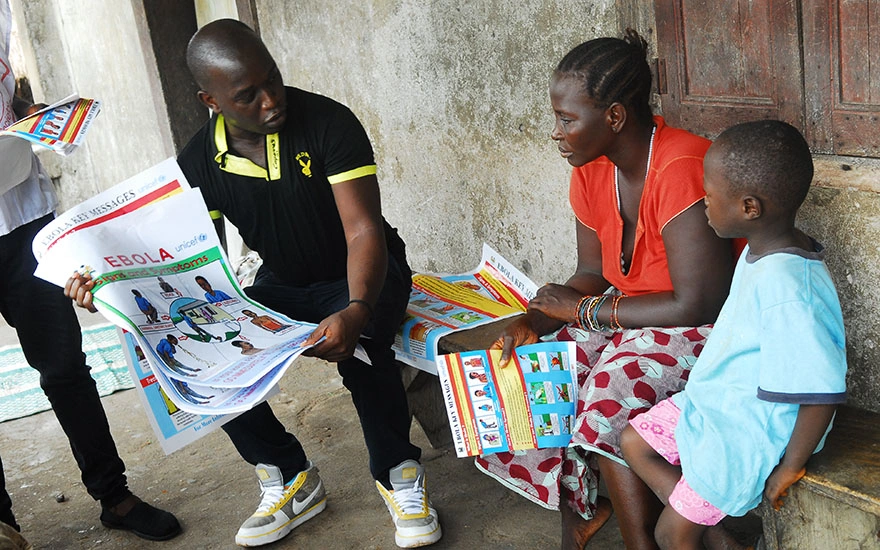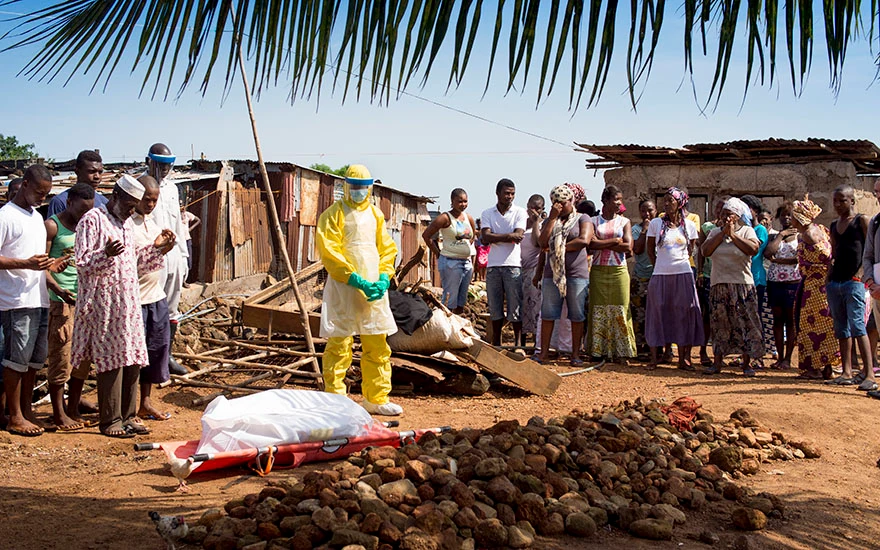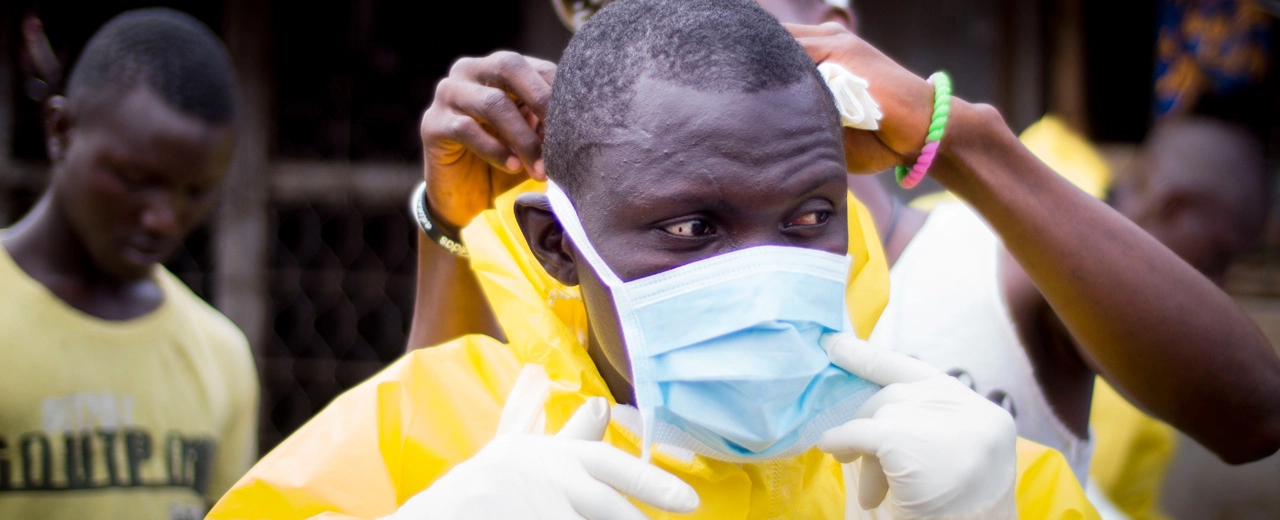The Ebola virus can kill up to 90% of people who become infected. From Sierra Leone to the DRC, we’ve been there to help stop its spread with our award-winning Ebola response.
As of January 13, 2020, there have been over 3,400 confirmed Ebola cases in the DRC and over 2,200 reported Ebola deaths. Over 223,000 Congolese have received the vaccine for Ebola, rVSV-ZEBOVGP. The WHO also reports 2 Ebola treatments being used in the DRC as part of a clinical trial which, when used at the right time, have been shown to save 9 out of 10 lives.
On July 17, 2019, the World Health Organization (WHO) declared an international health emergency for Ebola in the DRC. “It is time for the world to take notice and redouble our efforts," according to WHO Director General, Dr. Tedros Adhanom Ghebreyesus.
In June and July, 2019, EVD cases were confirmed in cities in the DRC close to borders with Rwanda and South Sudan. One Ebola-related death was confirmed in Uganda on July 7, 2019 and an additional case was confirmed in Uganda on August 29, 2019. These geographical areas have officials on alert to contain the spread and protect health workers and Ebola responders.
What is Ebola?
Ebola (also known as Ebola Virus Disease/EVD/EBOV, and formerly known as Ebola Hemorrhagic Fever) is a rare and deadly disease that was first discovered in 1976 with two simultaneous outbreaks in what is now the Democratic Republic of Congo (near the Ebola River) and South Sudan.

Causes
Ebola is highly infectious but it is not airborne. The deadly virus is contracted only via direct contact (through broken skin or mucous membranes) with the blood, secretions, organs, or other bodily fluids of infected humans or animals. Most infections are the result of human-to-human contact, including the handling of infected corpses as part of burial rites and traditions for Ebola victims. It’s also contracted through the preparation and eating of bush meat such as fruit bats, which host the disease.
Symptoms
Initial ebola symptoms are flu-like and may include:
- Fever
- Sore throat
- Muscle pain
- Headaches
These symptoms soon give way to vomiting, diarrhea and rashes. Eventually, organs begin to fail and patients experience internal and external bleeding.
Ebola treatment
Fatality rates can be up to 90%. There is currently no proven cure, though early rehydration therapy and treatment of other symptoms and potential infections can improve chances of survival.
Currently in the DRC, the World Health Organization has been testing an experimental vaccine called rVSV-ZEBOV (after a successful test in the country’s northwestern province of Equateur in July 2018). Initial results are promising in protecting against the Ebola virus. More than 200,000 Congolese have been vaccinated.
During the 2014-16 outbreak in West Africa, the vaccine was given to over 16,000 volunteers in Africa, Europe, and the United States and was found across multiple tests to be safe and protective. According to the WHO, more research is required before the vaccine can be licensed, but in the meantime is being used on “compassionate basis” in eastern Congo under a “ring vaccination” strategy.
The WHO also reports two Ebola treatments being used in the DRC as part of a clinical trial which, when used at the right time, have been shown to save 9 out of 10 lives.
The 2014-2016 Ebola epidemic
In March 2014, a case of Ebola was confirmed in the West African country of Guinea. From there, the disease spread to Liberia, Sierra Leone, Nigeria, and Senegal. A separate outbreak was also recorded in the Democratic Republic of Congo. By 2016, it became the world’s largest outbreak and the first to reach epidemic proportions. As of May 8, 2016, the WHO estimated a total of 28,646 cases and 11,323 deaths. A global health emergency, the outbreak officially ended on June 9, 2016.
Concern had been working in the two countries hardest hit by the outbreak — Sierra Leone and Liberia — for years prior to the epidemic. Already on the ground, we were one of the first NGOs to respond to the crisis, immediately diverting existing resources to help fight the spread of the disease. Our safe and dignified burials program in Sierra Leone was honored at the 2015 EU Health Awards.

Our approach to outbreak response
Prevention requires both education and supplies.
Education
In many countries hit hardest by these outbreaks, both the general population and many healthcare workers lack accurate information about how the disease is spread and how they can protect themselves. Responders in any Ebola outbreak face an enormous amount of myth, fear and misinformation, so our first response is to provide people with the information they need to keep themselves safe. Some of our educational activities include:
- Printing and disseminating thousands of awareness posters and factsheets
- Airing radio messages to educate people on risk factors
- Training health care workers, community health volunteers (CHVs), traditional birth attendants, village leaders, and traditional healers on symptoms and prevention
- Educating journalists and radio reporters on the media’s role in preventing Ebola
- Funding the training of clinical staff in hospitals
- Tackling the many dangerous myths about Ebola and how it is transmitted
- Changing behaviors that put people at risk, like eating bush meat or washing the dead
Health Center & Burial Support
The medical response doesn’t just require doctors: it requires supplies, logistics and funding. Frontline personnel often lack basic supplies like gloves. Additionally, Ebola’s spread can often be exacerbated by burial practices. During the 2014-16 West African outbreak, we worked with local teams to provide safe burials for Ebola victims. Our existing footprint in many of these countries means we’re well-positioned to deliver critical support, including:
- Essential protective equipment, like aprons, gloves, and masks
- Hand washing and disinfecting stations
- Vehicles for burial teams
- Spare parts and servicing to keep ambulances running
- Incentives to community health volunteers
- Social mobilization strategy
Government & Continuing Program Support
The impact of Ebola is much broader than the disease itself. Because of the enormous strain on the medical system, other people often die of preventable disease. Symptoms of common illnesses like malaria and typhoid are similar to those of Ebola, so patients are avoiding clinics for fear of being misdiagnosed. Pregnant women are also avoiding clinics thinking that they will contract the disease. Livelihoods, food security and education are also impacted. This is when our core programs are needed most and we are striving to keep them running where we can. We also provide advice and support to key government agencies to ensure their response is as robust as possible, including:
- Seconding staff to the Ministry of Health to support contact tracing
- Providing technical and logistical advice and assistance at every level of governmental response, from local to district to national – wherever our expertise is needed most
- Where possible, continuing development work that promotes livelihood security and builds resilience at the household and community level
- Where possible, continuing community health support through hygiene promotion, provision of clean water points and construction of latrines to prevent the transmission of not only Ebola but also other illnesses such as malaria and diarrhea that continue to threaten communities

